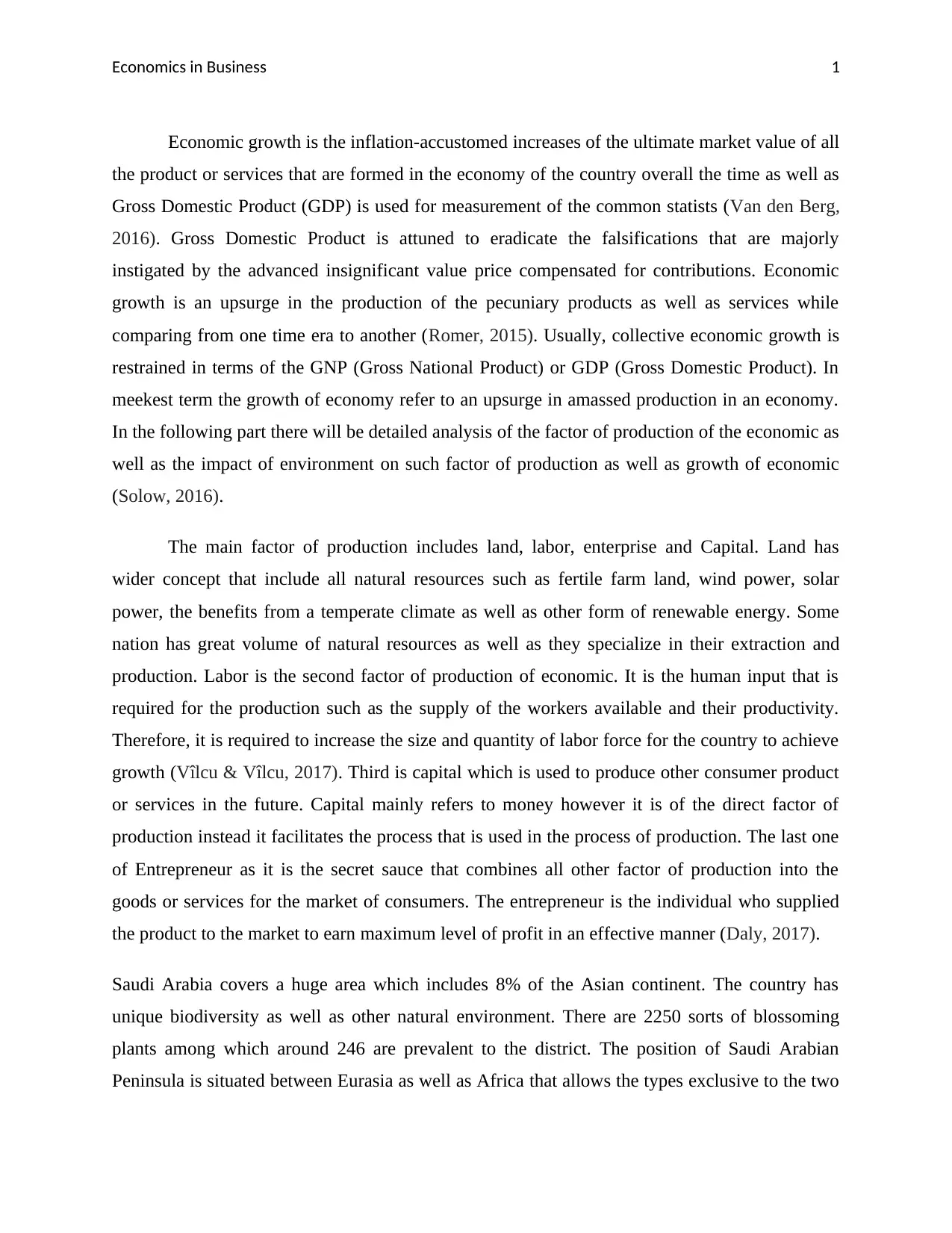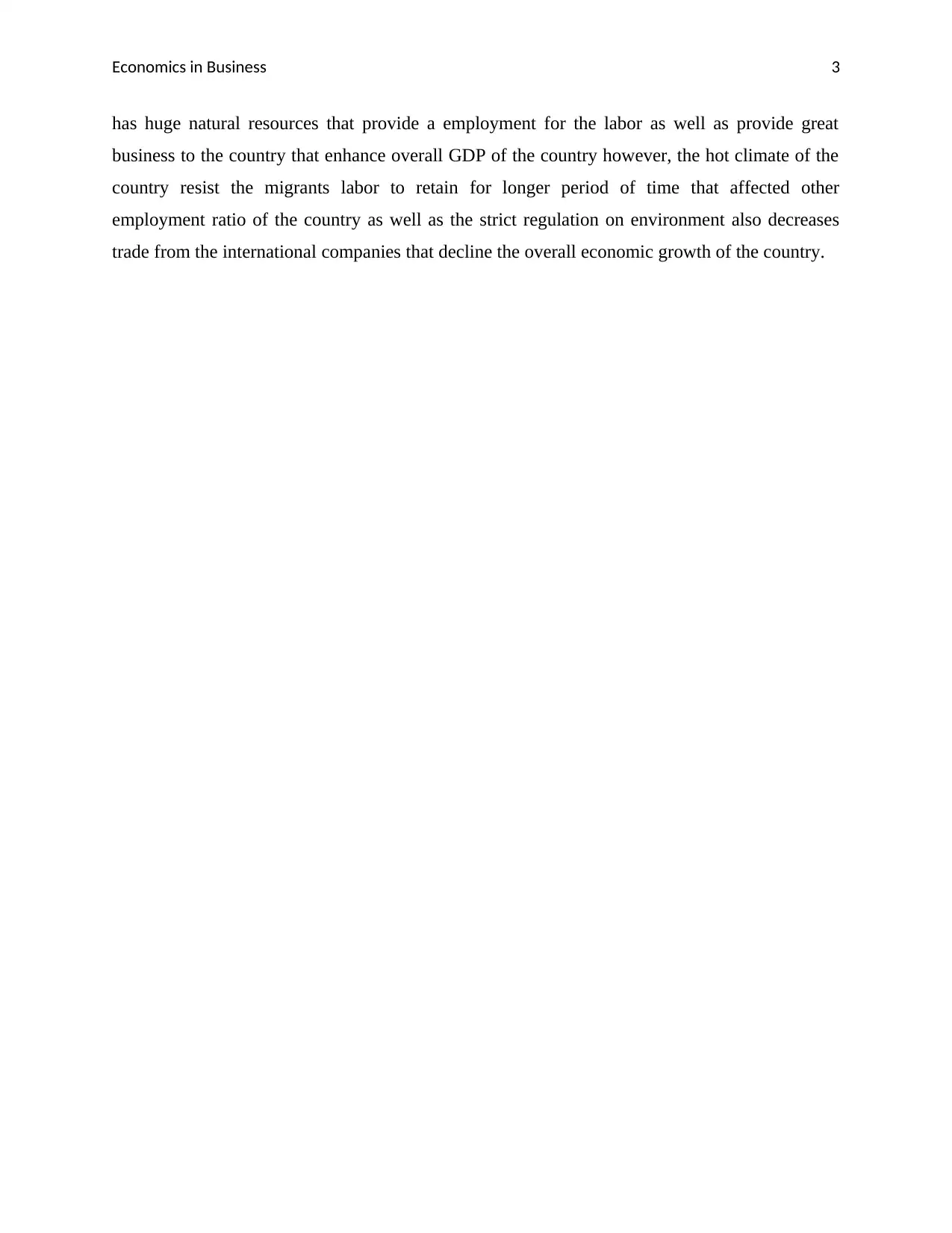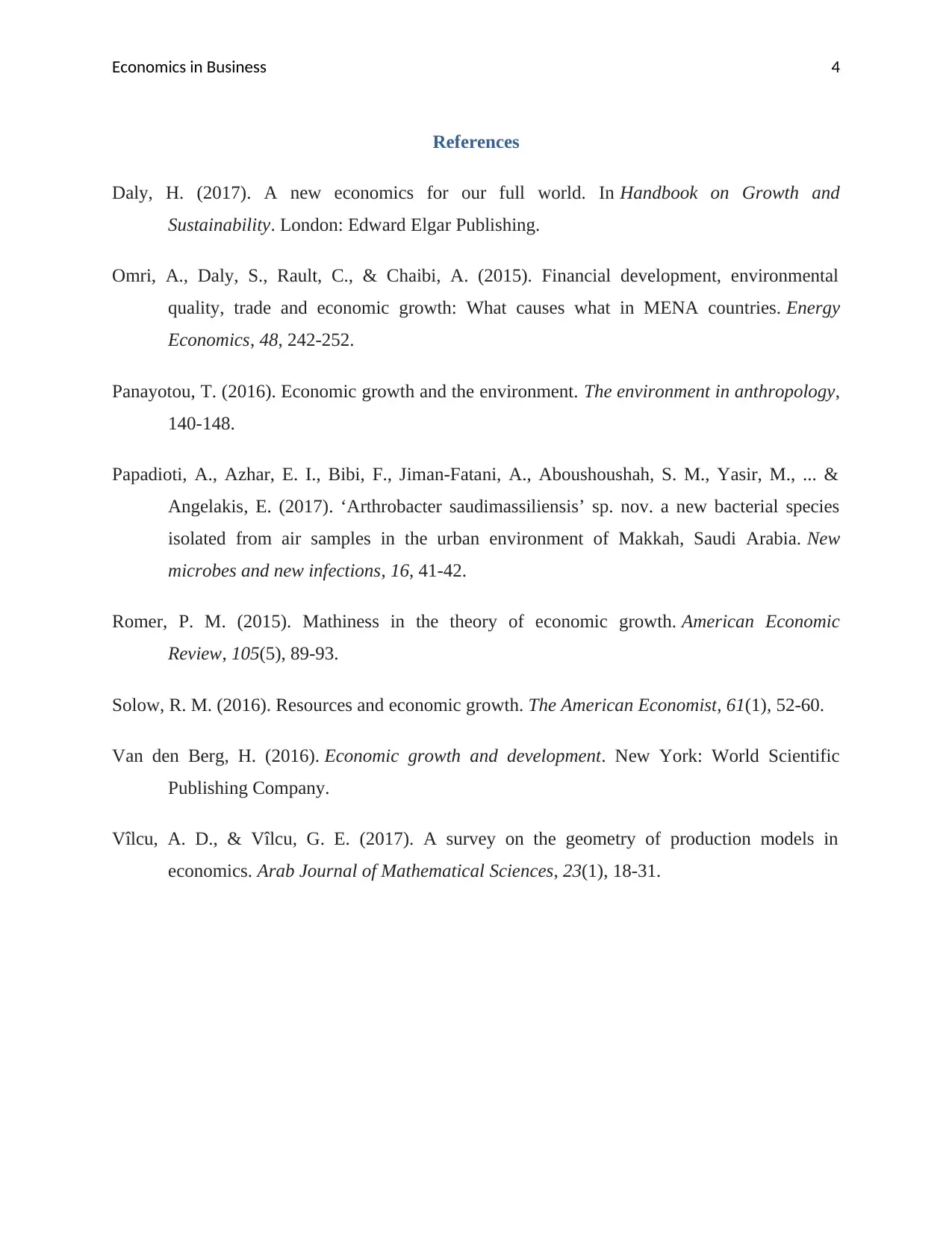Analysis of Economic Growth Factors and Environmental Influences
VerifiedAdded on 2022/10/14
|5
|1372
|11
Essay
AI Summary
This essay examines economic growth, defined as the increase in a country's production over time, measured by GDP, and driven by factors of production including land, labor, capital, and entrepreneurship. The essay analyzes the factors of production and discusses the environmental issues impacting labor and economic growth in Saudi Arabia. It explores how Saudi Arabia's unique biodiversity and climate, alongside industrial activities, affect its labor force, employment rates, and GDP. The analysis covers the impact of the environment on the labor force, employment ratios, and international trade, concluding that environmental regulations and climate conditions significantly affect economic growth. The essay uses scholarly references to support its arguments.

Running Head: Economics in Business 0
Economics in Business
(Student Name)
Economics in Business
(Student Name)
Paraphrase This Document
Need a fresh take? Get an instant paraphrase of this document with our AI Paraphraser

Economics in Business 1
Economic growth is the inflation-accustomed increases of the ultimate market value of all
the product or services that are formed in the economy of the country overall the time as well as
Gross Domestic Product (GDP) is used for measurement of the common statists (Van den Berg,
2016). Gross Domestic Product is attuned to eradicate the falsifications that are majorly
instigated by the advanced insignificant value price compensated for contributions. Economic
growth is an upsurge in the production of the pecuniary products as well as services while
comparing from one time era to another (Romer, 2015). Usually, collective economic growth is
restrained in terms of the GNP (Gross National Product) or GDP (Gross Domestic Product). In
meekest term the growth of economy refer to an upsurge in amassed production in an economy.
In the following part there will be detailed analysis of the factor of production of the economic as
well as the impact of environment on such factor of production as well as growth of economic
(Solow, 2016).
The main factor of production includes land, labor, enterprise and Capital. Land has
wider concept that include all natural resources such as fertile farm land, wind power, solar
power, the benefits from a temperate climate as well as other form of renewable energy. Some
nation has great volume of natural resources as well as they specialize in their extraction and
production. Labor is the second factor of production of economic. It is the human input that is
required for the production such as the supply of the workers available and their productivity.
Therefore, it is required to increase the size and quantity of labor force for the country to achieve
growth (Vîlcu & Vîlcu, 2017). Third is capital which is used to produce other consumer product
or services in the future. Capital mainly refers to money however it is of the direct factor of
production instead it facilitates the process that is used in the process of production. The last one
of Entrepreneur as it is the secret sauce that combines all other factor of production into the
goods or services for the market of consumers. The entrepreneur is the individual who supplied
the product to the market to earn maximum level of profit in an effective manner (Daly, 2017).
Saudi Arabia covers a huge area which includes 8% of the Asian continent. The country has
unique biodiversity as well as other natural environment. There are 2250 sorts of blossoming
plants among which around 246 are prevalent to the district. The position of Saudi Arabian
Peninsula is situated between Eurasia as well as Africa that allows the types exclusive to the two
Economic growth is the inflation-accustomed increases of the ultimate market value of all
the product or services that are formed in the economy of the country overall the time as well as
Gross Domestic Product (GDP) is used for measurement of the common statists (Van den Berg,
2016). Gross Domestic Product is attuned to eradicate the falsifications that are majorly
instigated by the advanced insignificant value price compensated for contributions. Economic
growth is an upsurge in the production of the pecuniary products as well as services while
comparing from one time era to another (Romer, 2015). Usually, collective economic growth is
restrained in terms of the GNP (Gross National Product) or GDP (Gross Domestic Product). In
meekest term the growth of economy refer to an upsurge in amassed production in an economy.
In the following part there will be detailed analysis of the factor of production of the economic as
well as the impact of environment on such factor of production as well as growth of economic
(Solow, 2016).
The main factor of production includes land, labor, enterprise and Capital. Land has
wider concept that include all natural resources such as fertile farm land, wind power, solar
power, the benefits from a temperate climate as well as other form of renewable energy. Some
nation has great volume of natural resources as well as they specialize in their extraction and
production. Labor is the second factor of production of economic. It is the human input that is
required for the production such as the supply of the workers available and their productivity.
Therefore, it is required to increase the size and quantity of labor force for the country to achieve
growth (Vîlcu & Vîlcu, 2017). Third is capital which is used to produce other consumer product
or services in the future. Capital mainly refers to money however it is of the direct factor of
production instead it facilitates the process that is used in the process of production. The last one
of Entrepreneur as it is the secret sauce that combines all other factor of production into the
goods or services for the market of consumers. The entrepreneur is the individual who supplied
the product to the market to earn maximum level of profit in an effective manner (Daly, 2017).
Saudi Arabia covers a huge area which includes 8% of the Asian continent. The country has
unique biodiversity as well as other natural environment. There are 2250 sorts of blossoming
plants among which around 246 are prevalent to the district. The position of Saudi Arabian
Peninsula is situated between Eurasia as well as Africa that allows the types exclusive to the two

Economics in Business 2
landforms. The forest is cutting down to provide land to the business. The industries are setting
up due to extraction of crude oil and fossil fuels that is used for many purpose (Papadioti et al.,
2017). It created negative impact on the environment however, it provide huge job opportunity to
the labor. The setting up of the industry in Saudi Arabia enhance the employment ratio of the
country that support in enhancing the standard of living of the individual in an efficient manner.
The labor force participation rate is 65.40% that represent the average growth of the employment
ratio. Furthermore, the crude oil and fossil fuel provide great business to the country that
enhances its GDP. The current GDP of the country is $68,382 billion which is growth of 2.2%.
The employment ratio in such country is high that contributed towards the growth of economic
in an effective and efficient manner. Therefore, the environment and other resources of the
country has positively affected over the labor as well as growth of economic in an effective
manner (Panayotou, 2016).
The climate of Saudi Arabia is generally hot as well as dry, although nights with the frost
ensue in the twilight. The moisture along the costs is also high. The temperature in the
summertime is comparatively high which reaches of over 45 degree Celsius with usually icy
nights. Such unbalanced weather created great impact on the labor to retain. The migrant’s
employees face huge issue in managing such weather that may cause illness and other diseases
that resist them to survive in such country. It creates an option for the labor to switch to other
country where they can able to work more efficiently and in healthy manner. Moreover, the
government has also introduced some strict rule to protect the environment that enhances cost to
the company which directly impacted over the wages of the labor to the certain extent.
Therefore, the labor resists staying in such country. Furthermore, the growth of economic also
affected from the environmental issues at greater level due to the reason, the regulation on
environment affected over the international trade of the country. The strict regulation resists the
other companies to entre in the market that create loss to the company in foreign exchange. The
GDP of the country is also fallen down due to such reason (Omri, Daly, Rault & Chaibi, 2015).
From the above analysis it can be concluded that growth of economy play a vital role for
the development of the country. The economic growth is determined through the GDP of the
country. Therefore, it is required for the country to maintain high GDP to achieve economic
growth. Saudi is one of the developed countries that are known for petrol and oil. The country
landforms. The forest is cutting down to provide land to the business. The industries are setting
up due to extraction of crude oil and fossil fuels that is used for many purpose (Papadioti et al.,
2017). It created negative impact on the environment however, it provide huge job opportunity to
the labor. The setting up of the industry in Saudi Arabia enhance the employment ratio of the
country that support in enhancing the standard of living of the individual in an efficient manner.
The labor force participation rate is 65.40% that represent the average growth of the employment
ratio. Furthermore, the crude oil and fossil fuel provide great business to the country that
enhances its GDP. The current GDP of the country is $68,382 billion which is growth of 2.2%.
The employment ratio in such country is high that contributed towards the growth of economic
in an effective and efficient manner. Therefore, the environment and other resources of the
country has positively affected over the labor as well as growth of economic in an effective
manner (Panayotou, 2016).
The climate of Saudi Arabia is generally hot as well as dry, although nights with the frost
ensue in the twilight. The moisture along the costs is also high. The temperature in the
summertime is comparatively high which reaches of over 45 degree Celsius with usually icy
nights. Such unbalanced weather created great impact on the labor to retain. The migrant’s
employees face huge issue in managing such weather that may cause illness and other diseases
that resist them to survive in such country. It creates an option for the labor to switch to other
country where they can able to work more efficiently and in healthy manner. Moreover, the
government has also introduced some strict rule to protect the environment that enhances cost to
the company which directly impacted over the wages of the labor to the certain extent.
Therefore, the labor resists staying in such country. Furthermore, the growth of economic also
affected from the environmental issues at greater level due to the reason, the regulation on
environment affected over the international trade of the country. The strict regulation resists the
other companies to entre in the market that create loss to the company in foreign exchange. The
GDP of the country is also fallen down due to such reason (Omri, Daly, Rault & Chaibi, 2015).
From the above analysis it can be concluded that growth of economy play a vital role for
the development of the country. The economic growth is determined through the GDP of the
country. Therefore, it is required for the country to maintain high GDP to achieve economic
growth. Saudi is one of the developed countries that are known for petrol and oil. The country
⊘ This is a preview!⊘
Do you want full access?
Subscribe today to unlock all pages.

Trusted by 1+ million students worldwide

Economics in Business 3
has huge natural resources that provide a employment for the labor as well as provide great
business to the country that enhance overall GDP of the country however, the hot climate of the
country resist the migrants labor to retain for longer period of time that affected other
employment ratio of the country as well as the strict regulation on environment also decreases
trade from the international companies that decline the overall economic growth of the country.
has huge natural resources that provide a employment for the labor as well as provide great
business to the country that enhance overall GDP of the country however, the hot climate of the
country resist the migrants labor to retain for longer period of time that affected other
employment ratio of the country as well as the strict regulation on environment also decreases
trade from the international companies that decline the overall economic growth of the country.
Paraphrase This Document
Need a fresh take? Get an instant paraphrase of this document with our AI Paraphraser

Economics in Business 4
References
Daly, H. (2017). A new economics for our full world. In Handbook on Growth and
Sustainability. London: Edward Elgar Publishing.
Omri, A., Daly, S., Rault, C., & Chaibi, A. (2015). Financial development, environmental
quality, trade and economic growth: What causes what in MENA countries. Energy
Economics, 48, 242-252.
Panayotou, T. (2016). Economic growth and the environment. The environment in anthropology,
140-148.
Papadioti, A., Azhar, E. I., Bibi, F., Jiman-Fatani, A., Aboushoushah, S. M., Yasir, M., ... &
Angelakis, E. (2017). ‘Arthrobacter saudimassiliensis’ sp. nov. a new bacterial species
isolated from air samples in the urban environment of Makkah, Saudi Arabia. New
microbes and new infections, 16, 41-42.
Romer, P. M. (2015). Mathiness in the theory of economic growth. American Economic
Review, 105(5), 89-93.
Solow, R. M. (2016). Resources and economic growth. The American Economist, 61(1), 52-60.
Van den Berg, H. (2016). Economic growth and development. New York: World Scientific
Publishing Company.
Vîlcu, A. D., & Vîlcu, G. E. (2017). A survey on the geometry of production models in
economics. Arab Journal of Mathematical Sciences, 23(1), 18-31.
References
Daly, H. (2017). A new economics for our full world. In Handbook on Growth and
Sustainability. London: Edward Elgar Publishing.
Omri, A., Daly, S., Rault, C., & Chaibi, A. (2015). Financial development, environmental
quality, trade and economic growth: What causes what in MENA countries. Energy
Economics, 48, 242-252.
Panayotou, T. (2016). Economic growth and the environment. The environment in anthropology,
140-148.
Papadioti, A., Azhar, E. I., Bibi, F., Jiman-Fatani, A., Aboushoushah, S. M., Yasir, M., ... &
Angelakis, E. (2017). ‘Arthrobacter saudimassiliensis’ sp. nov. a new bacterial species
isolated from air samples in the urban environment of Makkah, Saudi Arabia. New
microbes and new infections, 16, 41-42.
Romer, P. M. (2015). Mathiness in the theory of economic growth. American Economic
Review, 105(5), 89-93.
Solow, R. M. (2016). Resources and economic growth. The American Economist, 61(1), 52-60.
Van den Berg, H. (2016). Economic growth and development. New York: World Scientific
Publishing Company.
Vîlcu, A. D., & Vîlcu, G. E. (2017). A survey on the geometry of production models in
economics. Arab Journal of Mathematical Sciences, 23(1), 18-31.
1 out of 5
Related Documents
Your All-in-One AI-Powered Toolkit for Academic Success.
+13062052269
info@desklib.com
Available 24*7 on WhatsApp / Email
![[object Object]](/_next/static/media/star-bottom.7253800d.svg)
Unlock your academic potential
Copyright © 2020–2025 A2Z Services. All Rights Reserved. Developed and managed by ZUCOL.





